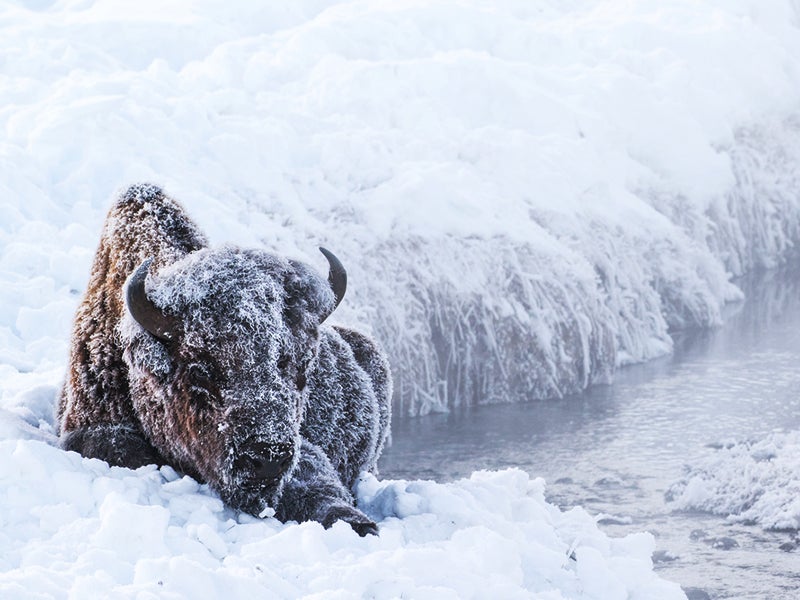Snowed in: How 6 Species Brave the Winter
Bison and grizzly bears and martens—oh my! The species Earthjustice works to protect can show us some of the best winter survival hacks.

This page was published 9 years ago. Find the latest on Earthjustice’s work.
What do bison, monarch butterflies, grizzly bears, martens, wolves and wood frogs have in common? All of these species, some of which Earthjustice works to protect, are known for their unique ways of combatting the winter cold.
American Bison
Now officially deemed by the U.S. Senate to be American icons, bison historically roamed the wide, sparsely-populated grasslands of North America. A Native American symbol of endurance and protection, it should come as no surprise that bison have adapted to life in the grasslands, snow or shine. In order to reach the vegetation these huge animals rely on for sustenance, bison use their massive heads as plows to push past fresh powder to the grasses underneath. Bison are able to avoid a brain freeze by growing a thick, dark coat of hair for the winter season.
Unfortunately, while the cold can’t stop this iconic species, human development and expansion into bison habitat is decimating the population. Earthjustice has been fighting to keep wild lands free from illegal oil and gas drilling in the Badger Two-Medicine area, where there is a bison reserve managed by the Blackfeet Nation. Without sufficient open land, this wide-ranging species may become extinct.
Monarch Butterflies
One of the most well-known animal wintering techniques is one many of us can relate to: running away! Several species are known for their migratory habits, including Canada geese, blue whales, wildebeests and monarch butterflies. Monarchs navigate with a sun compass that detects day length and temperature. They begin to migrate south when they detect shorter days and colder temperatures.
However, this ingenious technique does not account for climate change. The drought conditions in North and Central America have already made the seasonal migration for monarch butterflies difficult. However, temperature changes due to climate change may result in no migration at all. Moreover, monarch butterfly reproduction is also tied to day length and temperature. Without the weather fluctuations that trigger migration, monarch butterfly reproduction may be significantly impacted.
Grizzly Bears
Hibernation: an iconic wintering technique employed most famously by grizzly bears. In order to survive food shortages, low temperatures and snow, grizzly bears den for several months at a time. Entering a state of hibernation causes bears to decrease their body temperatures by more than 10 degrees Fahrenheit, reduce their heart rates and slow their respiration rates to one breath every 45 seconds. Unlike most other mammals that hibernate, grizzly bears remain in that state for the whole denning season without waking to raise their temperature, move around, urinate or eat.
Grizzly bears are able to survive on the fat they’ve stored and recycle their metabolic waste while hibernating. The potential dangers of denning for months at a time during hibernation mean grizzly bears are selective when it comes to choosing a winter home. However, the options are becoming fewer and fewer as grizzly bears’ preferred habitat is threatened by destruction and fragmentation due to human development. Earthjustice has worked for years to protect grizzly bears in the Greater Yellowstone ecosystem , including securing a 2011 court victory that reinstated federal Endangered Species Act protections for this iconic grizzly bear population.
American Martens
Instead of hiding or fleeing from the snow, during winter American martens occupy the small habitat that is the gap between fallen snow and ground. Martens are related to minks, weasels and otters. Martens live in mature coniferous forests or mixed temperate forests, which provide good cover to hide from predators and protected, shallow spaces on the forest floor for winter foraging and dwelling. There’s evidence that martens travel extensively under snow cover; under-snow trails of up to 98 feet were found in Oregon.
However, these under-snow trailblazers in Oregon and Northern California are under threat and under-protected by the U.S. Fish and Wildlife Service. Fewer than 100 martens exist in California, and these coastal martens no longer inhabit 83 percent of their historic range. Earthjustice recently sued the Fish and Wildlife Service for opting not to protect the coastal martin under the Endangered Species Act.
Alexander Archipelago Wolves
In the Tongass National Forest in southeastern Alaska, Alexander Archipelago wolves employ a wintering strategy that fulfills their need for protection from the elements as well as food. Alexander Archipelago wolves are an extremely rare, small population of wolves whose home range spans the Alaskan panhandle. In the span of 20 years, the population of these wolves has decreased from 900 to roughly 60.
The Tongass National Forest is home to centuries-old trees that have thus far been protected from timber industry projects due in part to lawsuits filed by Earthjustice. Alexander Archipelago wolves den in the root systems of these massive trees for protection during the winter months. Deer, the primary prey of these wolves, rely on these same trees for shelter from the heavy snow—a win-win situation for the wolves that remain.
North American Wood Frogs
While the aforementioned wintering techniques are all unique, the most incredible and awe-inspiring winter survival tactic has been honed by the North American wood frog. These frogs essentially shut down without a heartbeat and freeze internally during the winter months, then miraculously thaw within 30 minutes at the onset of spring to eat and mate. Wood frogs live across North America from the northeastern United States through British Columbia and from Canada to Alaska.